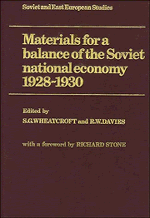2 - ARTICLES
Published online by Cambridge University Press: 26 October 2011
Summary
GENERAL RESULTS OF THE NATIONAL ECONOMIC BALANCE FOR 1928, 1929 AND 1930
A. Petrov
[A] Introductory notes
The purpose of the national economic balance of the USSR is to study regularities in the process of reproduction of the economy during the transition period between capitalism and socialism; it examines the actual state of the economy at different stages in the building of socialism.
Economic reproduction during the transition period is planned, and all plans at a national economic level are plans of reproduction. The national economic balance can therefore be used as a synthetic method for studying reproduction both in the past and in economic plans for the future (quarterly, annual, five-year, etc.). The balance method of economic planning is a method for synthetically coordinating the plan, with the object of achieving in practice the basic directives of the Party general line. The synthetically coordinated economic plan will be both a plan and a balance.
At every stage of Soviet economic development reproduction is expanded socialist reproduction and is concerned both with expanded reproduction of the socialist economy in material terms and with expanded reproduction of socialist production relations. Expanded socialist reproduction is a process of struggle against capitalism, restricting, supplanting and eliminating capitalism, and transforming petty commodity economics into socialist economy (the collectivisation of agriculture, the cooperative organisation of small-scale industry).
- Type
- Chapter
- Information
- Publisher: Cambridge University PressPrint publication year: 1985



